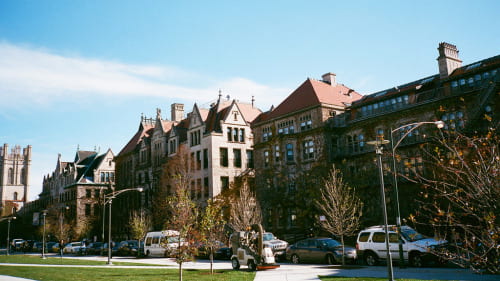Laboratory Projects Reduce Energy

Since 2018, the University of Chicago has performed detailed energy audits and system testing at the most energy-intensive buildings on campus through its Preventative Maintenance and Commissioning (PM+Cx) program. Laboratory facilities have been a focal point of the UChicago energy management efforts as they are responsible for 40% of the University’s energy consumption. Recently completed PM+Cx projects at the Biopsychological Research Building, Zoology Building, and Jones Laboratory significantly reduced energy use and improved building performance.
At the Biopsychological Research Building, projects included recalibration of temperature sensors to improve control and reduce overcooling, optimization of ventilation rates in laboratory spaces, and temperature setbacks during periods of low occupancy.
Projects implemented at the Zoology building recalibrated and tested laboratory fume hoods and replaced outdated heating and cooling valves. In addition, laboratory air distribution systems were rebalanced to optimize ventilation rates, reducing energy required to move air and heat and cool spaces. This measure alone is expected to save 152 metric tons eCO2 per year – equivalent to greenhouse gas emissions from 32 gasoline-powered passenger vehicles driven for one year.
Operating schedules for building heating and cooling equipment at Jones Laboratory were adjusted to respond to the varying changes in building usage and occupancy throughout the academic year. An economizer sequence was also added to use outside air for cooling when conditions allow.
Reducing the carbon footprint of campus buildings requires a strong partnership between Facilities Services and the students, researchers, faculty, and staff that occupy and use these buildings. “Sustainability is important to us in the Chemistry department. We are open to exploring how we can contribute more to this area safely and effectively without harming the staff or research”, adds Michael Reedy (Building Manager and Safety Officer, Chemistry Department).
This partnership yielded significant energy and greenhouse gas emissions reductions. The energy saved across these projects will reduce greenhouse gas emissions by 405 metric tons eCO2 per year, which is equivalent to eliminating the annual emissions from 25 US homes each year.

The University of Chicago is a two-time recipient of the United States Environmental Protection Agency ENERGY STAR® Partner of the Year award, collaborating with peer institutions to reduce higher education campus energy usage. The goal of this energy efficiency program is to: (1) reduce the impact on the environment as about 70 percent of University greenhouse gas emissions are from energy usage in campus buildings; (2) redirect funds currently going to utility providers back into the maintenance of our campus buildings; and (3) reduce the risk of disruption to our educational and research mission by locating and correcting issues before systems and components in our buildings fail. More than 200 energy efficiency measures have been completed in the University of Chicago campus buildings since 2009, and buildings will continue to be the primary target of our efforts to reduce greenhouse gas emissions.
